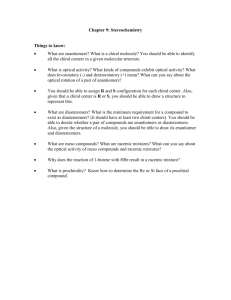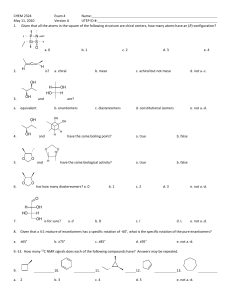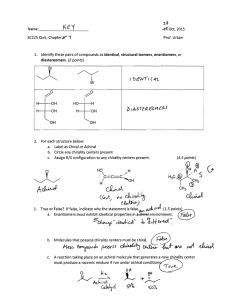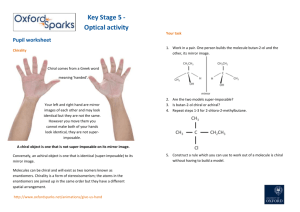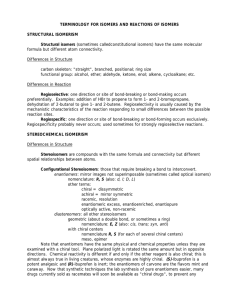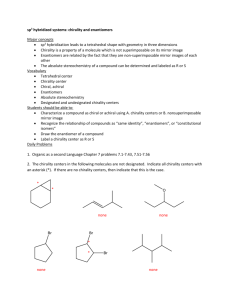STEREOCHEMISTRY A STUDENT SHOULD BE ABLE TO: 1.
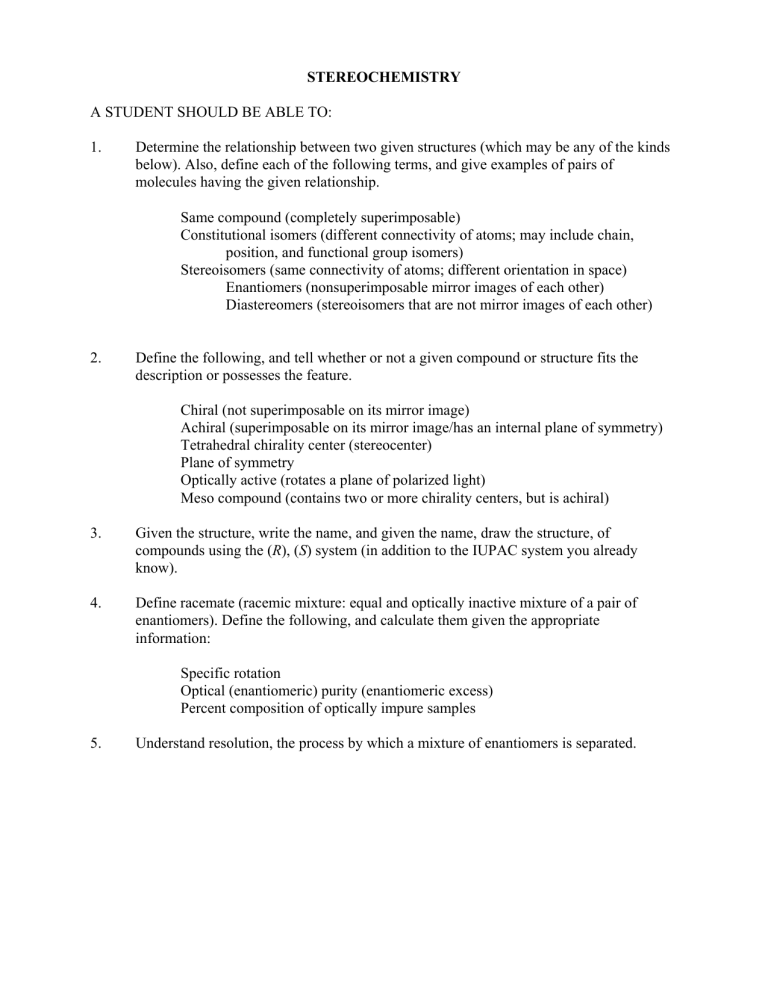
5.
3.
2.
STEREOCHEMISTRY
A STUDENT SHOULD BE ABLE TO:
1. Determine the relationship between two given structures (which may be any of the kinds below). Also, define each of the following terms, and give examples of pairs of molecules having the given relationship.
Same compound (completely superimposable)
Constitutional isomers (different connectivity of atoms; may include chain, position, and functional group isomers)
Stereoisomers (same connectivity of atoms; different orientation in space)
Enantiomers (nonsuperimposable mirror images of each other)
Diastereomers (stereoisomers that are not mirror images of each other)
Define the following, and tell whether or not a given compound or structure fits the description or possesses the feature.
Chiral (not superimposable on its mirror image)
Achiral (superimposable on its mirror image/has an internal plane of symmetry)
Tetrahedral chirality center (stereocenter)
Optically active (rotates a plane of polarized light)
Meso compound (contains two or more chirality centers, but is achiral)
Given the structure, write the name, and given the name, draw the structure, of compounds using the ( R ), ( S ) system (in addition to the IUPAC system you already know).
4. Define racemate (racemic mixture: equal and optically inactive mixture of a pair of enantiomers). Define the following, and calculate them given the appropriate information:
Optical (enantiomeric) purity (enantiomeric excess)
Percent composition of optically impure samples
Understand resolution, the process by which a mixture of enantiomers is separated.
To best prepare for this module, please work Chapter 5 Skill Builder problems in the textbook.
Please use your model kit to prepare for this module.
A STUDENT WHO HAS MASTERED THE OBJECTIVES FOR THIS UNIT SHOULD BE
ABLE TO SOLVE THE FOLLOWING PROBLEMS AND RELATED ONES:
1.1 State how the two structures in each of the following pairs are related to each other. They may be constitutional (structural) isomers, enantiomers, diastereomers, or the same compound.
1.2 Identify each of the compounds in question 1.1 above as either chiral or achiral.
1.3 Answer the following questions for each of the following sets of four structures.
1) Which of the other three members of each set is not a stereoisomer of the first member of the set?
2) Which two members of each set are enantiomers of one another?
3) What relationship do the two members that are not enantiomers of one another have with the two that are enantiomers of one another? (See 1.1 for possible relationships.)
2.1 Answer the following questions for each of the molecules shown below.
1) How many chirality centers does the molecule contain?
2) Does the molecule possess any internal planes of symmetry?
3) Is the molecule chiral?
4) Is the molecule superimposable on its own mirror image?
5) Is the molecule optically active?
6) Is this a meso compound?
2.2 How many chirality centers does the following structure contain? How many stereoisomers having this structure are theoretically possible?
HOH
2
C
O
CH
3
OH
CH
3
O
2.3 Which of the following compounds has a meso stereoisomer?
3.1 What is the correct priority of these groups with respect to ( R ), ( S ) determination in stereochemistry, with highest priority group first? Assume these groups are all bonded to the same chirality center. a) -CH
2
CH
2
Cl -CH
2
OH b) -CH
2
Br -CHF
2
3.2 Label the following chirality centers as ( R ) or ( S )
-CH=CH
2
-OCH
3
-C(CH
3
)
3
-Cl
3.3 Give the IUPAC name, including the ( R ) or ( S ) designations when appropriate, of each of the following compounds.
3.4 Draw the structure of each of the compounds named below. Make sure that your drawing shows a three-dimensional structure in the correct configuration.
( R )-2-chloropentane b) )-3-ethyl-4-methyl-1-hexyne
4.1 Sample A is a mixture of two enantiomers. A solution is made by dissolving 5.00 g of sample A in enough ethanol to bring the volume of solution to 25.0 mL. Some of the solution is placed in a 10.0 cm polarimeter cell and its optical rotation is measured at
25°C using light of the sodium D line wavelength (589.6 nm). The observed rotation is
-8.30°. What is the specific rotation of this sample?
4.2
An enantiomerically pure sample of the ( S ) enantiomer of A from problem 4.1 has a specific rotation of +72.3°. What is the % enantiomeric excess of sample A?
4.3 What percentage of sample A (problem 4.2 above) is the ( S ) enantiomer? What percentage of the sample is the ( R ) enantiomer?
4.4 You have a sample (Sample X) which is a mixture of +/- Carvone. The solution was made by dissolving 4.50 g of the sample in enough methanol to bring the volume of solution to 10.0 mL. Some of the solution is placed in a 100 cm polarimeter cell and its optical rotation is measured at 25°C using light of the sodium D line wavelength (589.6 nm). The observed rotation is +22.2°. What is the specific rotation of this sample?
4.5 An enantiomerically pure sample of the ( S ) enantiomer of Carvone has a specific rotation of +15.5°. What is the % enantiomeric excess of Sample X from problem 4.4?
4.6 What percentage of Sample X (problem 4.5 above) is the ( S ) enantiomer? What percentage of the sample is the ( R ) enantiomer?
5.1 Draw the product salts that result when a racemic mixture of the amine base reacts with the stereoisomer of the acid shown below. What is the relationship between the product salts? Would you expect their melting point or solubility to be the same or different?
CO
2
H
NH
2 acid-base
H OH
Ph CH
3 reaction
HO H
+
CO
2
H tartaric acid racemic
-phenylethylamine
SOLUTIONS TO SAMPLE PROBLEMS:
1.1 a) enantiomers c) enantiomers b) diastereomers d) same compound g) constitutional isomers i) same compound h) diastereomers j) enantiomers (hint: chairs can flip)
1.2 a) both are chiral, b) both chiral, c) both chiral, d) both achiral, e) left structure achiral and right structure chiral, f) both chiral, g) both achiral, h) both achiral, i) both chiral, j) both chiral, k) both chiral, l) both achiral.
III and
IV and
2.1 1) 2) 3) 4) 5) 6)
2
1
2
0
2.2 6 Tetrahedral chirality centers, 2
6
= 64 possible stereoisomers. However, some of the ring chirality centers cannot be varied independently, so the actual number is less than 64.
2.3 c
3.1 a) -CH
2
OH > -C(CH
3
)
3
> -CH=CH
2
> -CH
2
CH
2
Cl b) -Cl > -OCH
3
> -CH
2
Br > -CHF
2
3.2 c) )-3-chloro-4-fluoro-3,4-dimethylhexane d) )-4-chloro-3-methyl-1-pentene
( R )-2-chloropentane b) )-3-ethyl-4-methyl-1-hexyne
4.2 57.4 % ee
4.3 21.3% R )
Note: Your structure may be drawn differently and still be correct
4.5 31.8 % ee
4.6 65.9 % ( S ) and 34.1 % ( R )
5.1 Diastereomeric salts will form. They will have different properties (such as MP, solubility) that can be used to separate the isomers.
Name _______________________________________________ Sixth Drill Test (Sample A)
1.
2.
Consider the molecule at right, and answer each of the questions about it. a) Is it superimposable on its mirror image? _____ b) Is the molecule chiral? _____ c) Does it have a plane of symmetry? _____ d) Is it optically active? _____ e) Is it a meso compound? _____
Give the IUPAC name of each, using ( R ) or ( S ) when appropriate.
4.
3. a) A sample of ( S )-2-heptanol was found to have an optical purity (or % ee) of 30%.
What is the composition of the other 70% of the material? Show your work. b) The remaining 70% referred to in 3a could be called a ___________________.
What is the relationship between the structures in each of these pairs? Possible answers are: Same compound, Enantiomers, Diastereomers, and Constitutional (Structural) isomers.
Name _______________________________________________ Sixth Drill Test (Sample B)
1. Give the IUPAC name of each compound using ( R ), ( S ) designation where appropriate.
2. What is the relationship between the structures in each of the following pairs? Possible answers are: same compound, enantiomers, diastereomers, and constitutional isomers.
4. a) HO c)
H
HO
H
COOH
OH
H
CH
3
H
OH
HO
HO
HO
H
H
CH
3
COOH
H
OH
H b)
H
Cl
CH
3
NH
2 d)
H
HOOC
COOH
H
H
3
C
H
2
N
H
HOOC
Cl
H
H
COOH
3. A sample of 3-(3,4-dihydroxyphenyl)alanine has a specific rotation of -4.5°. The specific rotation of optically pure (–)-3-(3,4-dihydroxyphenyl)alanine is -11.5°. a) What is the optical purity (enantiomeric excess) of the sample? b) What is the percentage of (+)-3-(3,4-dihydroxyphenyl)alanine in the sample?
Draw the structure of a chiral cyclic alkane having a molecular formula of C
5
H
10
.

